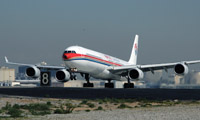News Backgrounder
Asia’s banking honey pot
In the next two decades the appetite of the emerging world’s middle class for travel will add a predicted 14,000 aircraft to Asia-Pacific airline fleets. Funding, too, is shifting as the region’s aircraft lessors and airlines turn increasingly to the rich of the Asia-Pacific to finance fleet expansion.
December 1st 2013
Knock on local doors when seeking financing is the advice of one of the region’s leading aircraft lessors because the industry has to find new ways of financing its business. Read More »
 |
| 'We have to get the message across to the region’s state, pension and insurance funds that this is a great industry for investment' |
| Robert Martin Managing Director and CEO BOC Aviation |
Managing director and CEO of BOC Aviation, Robert Martin, believes the airline industry should tap into the region’s wealth to fund the thousands of aircraft planned for delivery in the Asia-Pacific.
By 2018, the world aviation industry – which currently needs around $100 billion annually to fund aircraft – will require financing of $120 billion a year, Martin said. As a panel member at the recent Association of Asia Pacific Airlines (AAPA) Assembly of Presidents, the BOC boss said historically, industry financing came from the U.S. Ex-Im Bank, the European Export Credit Agency and Japanese and European banks.
“It is clear that is going to change. One thing we have to do in this part of the world is mobilize the growth of the region’s wealth and match it with the needs of our industry. The way that is going to happen is through the Asian banking system and through Asian capital markets,” he said.
Vast sources of funding are available because the state pension funds of countries across the region are growing and private pension funds are growing. “They need somewhere to invest their money. The aviation industry is a very stable cash flow industry. We have to get that message across to these funds so that they understand this is a great industry in which to invest for the long-term,” Martin said.
The BOC strategy underscores the wider global view of financiers who predict airlines will increasingly turn to capital markets to fund fleet development. Recent rule changes at institutions that were traditional sources for aircraft financing have increased borrowing costs.
Kostya Zolotusky, managing director, capital markets at Boeing’s financial arm, Boeing Capital Corporation, told Orient Aviation funding from Ex-Im agencies alone, which accounted for $29 billion, or about 30% of last year’s aircraft purchases, will fall to $24 billion, or 23%, of the $104 billion needed to finance aircraft acquisitions this year.
 |
| Shanghai-based China Eastern Airlines announced plans to issue up to US$1.4 billion in bonds to finance aircraft purchases, re-structure its loan book and general financing and replenish operating capital |
European-based commercial banks have been a major source of airplane funding. They were expected to provide $29 billion, or 28%, of finance for new aircraft in 2013. But they are restructuring their business units to meet regulatory guidelines being put in place in reaction to scrutiny of the industry in the aftermath of the 2008 Global Financial Crisis. Aircraft manufacturers, which often step in to assist the financing of their customers’ orders, are also easing back on their funding for new planes.
Martin forecast there will be another shift in the traditional method of aircraft financing - less use of the US$ - as pools of wealth across Asia are tapped. “We (BOC Aviation) just did our first off-shore Renminbi bond in Hong Kong. We raised one billion (Chinese) Renminbi of five-year unsecured money with more than 50% of the funds coming from private banks. This is an actual demonstration of the private wealth affect in Asia. It is really arriving,” he said.
Governments in the U.S. and Europe are facing increasing budgetary constraints, which will pressure export credit agencies to increase caps on lending and spending. Martin reflects a larger lessor view when he said that institutions outside the Asia-Pacific can be expected to match the growth in capital expenditure in the industry.
A major issue for many lessors in the region is the growth of the low-cost carrier sector of the industry. Flag carriers from Asia are familiar to global lenders, but the growing crop of new LCCs need brand recognition to tap loan funds. Martin said this will take time and education.
| 'Some European lenders have halved their lending availability for the aviation sector. They have tried to fill the gap by bringing in regional and local banks on syndicated deals. Traditional banks are now playing the role of arrangers' |
| Francois Collet Vice President for structured financing Airbus |
Tight financing has encouraged some airlines to lease rather than buy aircraft, but whatever the source of the funding, lessors look like being the biggest winners. In 1980, said Boeing’s Zolotusky, 1.7% of global commercial aircraft were leased. In 2012, the figure was 38%, with a prediction it will increase to 50% by 2020. “Probably over the next five to seven years, as regulation of banking is formalized, there will be less banking in general and less commercial banking available for aircraft,” he said.
Annual statistics illustrate the shrinkage in commercial bank lending. Two years ago, French banks were providing 32% of all commercial bank aircraft financing. This year its commitments were halved. The contribution of German banks in the industry sector has declined from 29% in 2010 to 21% this year. Even Chinese banks, who contributed 21% of airline lending in 2009, reported an investment of 11% a year later, although indicators are it will rise to 18% for the full 2013 year. Japanese banks have increased activity in the market in 2013, but final figures are not yet available.
Japanese banks may be in again, but 20 years ago there were some 15 active Japanese banks. Today, it’s probably a handful who are active in the market. It is not the big numbers seen previously, said Martin.
Five to ten years ago, Chinese banks mainly financed their own airline fleets, but they are now more participatory in international finance markets. Statistics indicate the big four [Chinese] banks are using their balance sheets globally with an emphasis in the Asia-Pacific. Opinion on the trend is mixed, but the point has been made that as China’s banks build their global portfolios their investments are not just in the Asia-Pacific. “I think you are going to see them as much bigger players going forward,” said Martin.
Airbus agrees with the general trends of bigger business for lessors in the region. Asian and Middle Eastern lenders are taking a larger share of the aircraft financing market, said Francois Collet, vice president for structured finance at Airbus.
“Some European lenders have halved their lending availability for the aviation sector. They have tried to fill the gap by bringing in other regional and local banks to work together in syndicated deals. Traditional banks are now playing the role of arrangers,” he said.
 |
| 'I sleep well at night because I can’t name another asset class that has performed better over the past 20 years or through the financial crisis. Until 2007, you could have said real estate, but not now' |
| Kostya Zolotusky managing director capital markets Boeing Capital Corporation |
Last year, French banks BNP Paribas, Société Generale, Natixis and other European lenders began cutting their exposure to risky and dollar-denominated assets such as shipping and aircraft financing to meet tougher capital rules and shore up reserves. They have given way to Development Bank of Japan, Sumitomo Mitsui Financial Group, Mitsubishi UFJ Financial Group, South Korean and Chinese banks, as well as as the National Bank of Abu Dhabi among others.
All the aircraft manufacturers, including Airbus, Boeing, Bombardier, Embraer and the smaller aircraft builders, agree on the changing numbers. In 2012, an average of 21% of aircraft leasing finance was from commercial banks, 30% provided by Ex-Im agencies, 14% from capital markets, 7% from lessor funding and the remaining 25% from airlines’ own cash resources or other sources. This year, 28% is expected to come from commercial banks, 23% from Ex-Im agencies, 5% from lessors, 15% from capital markets and the remainder from cash and other sources.
The big mover, it is universally believed, will be capital marking raisings, which just a few years ago accounted for 2% to 3% of aircraft financing. In 2013, capital markets are expected to contribute at least 15% of funding, with the figure accelerating in the next few years.
A major part of the growth will be in the issuance of bonds, such as Enhanced Equipment Trust Certificates (EETCs) – a secured bond backed by aircraft that can be purchased by investors. EETS until recently had been almost exclusively used in the U.S. for financing aircraft purchases and leases.
Virgin Australia recently completed an EETC deal. Emirates Airline has conducted a $1 billion public bond issue and in June this year British Airways broke ground by raising $927 million to upgrade its elderly fleet through a hybrid bond issue of EETCs. Air Canada also sold $411 million of the bonds in April and Asian carriers are jumping on the bandwagon.
Garuda Indonesia has offered $204.1 million in bonds to back expansion plans, part of a series of bond issues amounting to nearly $400 million over the next two years. About 80% of these funds will finance fleet expansion. In mid-year, China Eastern Airlines informed the Shanghai Stock Exchange it would issue up to $1.4 billion in corporate bonds, with the proceeds to be used to purchase aircraft, renegotiate bank loans, optimize financing and replenish operating capital. Hainan Airlines, a subsidiary of the fourth largest aviation and property conglomerate in China, the HNA Group, announced issuance of $500 million in bonds, backed by a standby letter of credit from the Bank of China.
Products such as the EETC are still very much a U.S. product directed at a U.S. investor market, lessors said. The region’s financiers are seeing a lot of the funds active in the U.S. setting up entities in the Asia-Pacific.
Martin said that lessors will do leases or sale lease-backs for airlines around the region and then go to the market. “We go in based on our own credit risk or put pools of aircraft together and issue debt and equity into the market place. That’s the market we see will grow significantly over the next five years,” he said.
Aircraft buyers’ issuance of bonds, backed by airplanes, are expected to double to about $30 billion next year. “Aircraft-backed bonds will fund about 15% of plane deliveries worldwide this year and rise to a ‘high twenties’ percentage of the market in 2014,” said Zolotusky. Boeing forecasts next year’s debt issuance will be equivalent to about 39% of such bonds issued globally since 1987, based on JPMorgan Chase research.
Analysts expect the trend will accelerate and that more major legacy airlines that have traditionally used commercial bank financing, including the Qantas Group and Singapore Airlines, will make forays into capital markets by attracting investment from pension funds, the insurance industry and big investment institutions.
Zolotusky emphasized that investments are made in the aircraft - the asset - not the airline. In the past, planes belonging to bankrupt airlines were often seized and held in limbo, turning them into non-productive assets. The practice was removed by the Cape Town convention, which converted aircraft into a relatively safe, high quality asset against which to lend.
He said the sector now offers attractive returns on investment at a time it is increasingly hard to get worthwhile yields from other avenues of income. Japanese banks recently paid high prices to acquire aircraft leasing assets, including purchase of the Royal Bank of Scotland’s leasing business by Sumitomo Mitsui Financial Group in 2012.
“If I had more airplanes (to finance), the capital markets would snap up everything they could. I sleep well at night because I can’t name another asset class (other than aircraft) that has performed better over the past 20 years or through the financial crisis. Until 2007, you could have said ‘real estate,’ but not now. Our track record of loss default is good,” said Zolotusky.